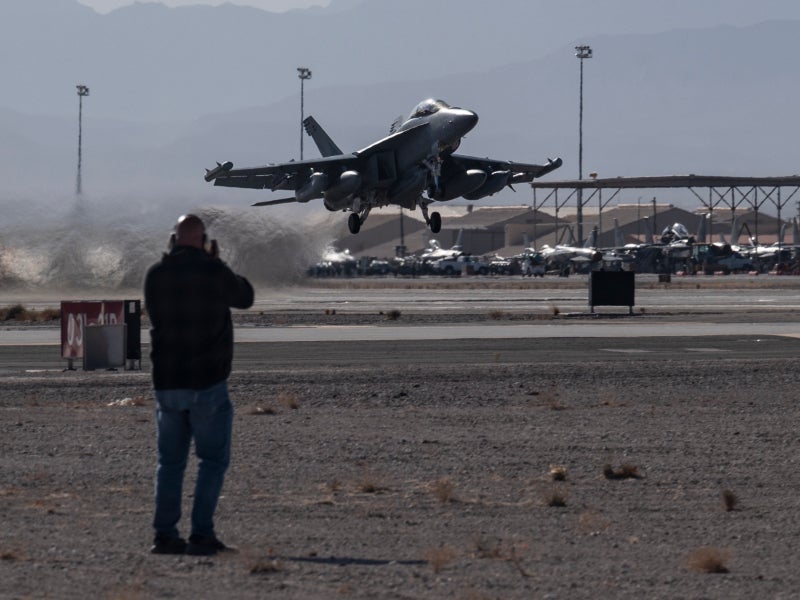EA-18G Growler is the most advanced airborne electronic attack (AEA) aircraft, capable of operating either from an aircraft carrier or from land bases. The Growler was developed as a replacement for the US Navy EA-6B Prowler aircraft, which entered service in 1971 and retired in March 2019.
The Growler is a derivative of the combat-proven two-seat F/A-18 Hornet, the US Navy’s maritime strike aircraft. The primary missions of the aircraft are electronic attack (EA) and suppression of enemy air defences (SEAD), particularly at the start and ongoing early stages of hostilities.
The Growler aircraft has 11 weapon stations for carrying electronic mission systems and weapons. It can be used to carry out conventional strike missions when the requirements for EA and SEAD sorties are reduced.
EA-18G Growler programme and development
The US Navy (USN) awarded a five-year system development and demonstration (SDD) contract in December 2003. A contract for the first four production aircraft was signed in July 2006.
The Growler aircraft’s first test flight was successfully completed in August 2006. This was followed by delivery of the first two test aircraft to the USN in September and November 2006. The first production aircraft was delivered to the USN in September 2007.
The first operational aircraft was delivered to Naval Air Station (NAS) Whidbey Island, Washington, in June 2008, and operational evaluation began in October 2008 on board the USS John C Stennis (CVN 74) aircraft carrier.
The SDD programme concluded with initial operational capability in late 2009, when the first of ten electronic attack squadrons (VAQ) began EA-18G operations. In service, the aircraft carries out a range of missions, including stand-off and escort jamming, surveillance, and strike.
Naval Air Systems Command PMA-265 is the USN acquisition office for the EA-18G. The Boeing Company is the prime contractor and weapon system integrator. Boeing also leads the EA-18G Growler industry team. Northrop Grumman is the principal subcontractor and airborne electronic attack subsystem integrator.
The EA-18G Growler fleet is based at NAS Whidbey Island.
Boeing was awarded a contract to deliver 12 Growlers to the Royal Australian Air Force (RAAF) under a foreign military sales agreement with the USN in June 2014. The aircraft achieved initial operational capability in April 2019 and are currently operated by the RAAF. Australia is the first country outside the US to operate the EA-18G Growler aircraft.
An EA-18G Growler, along with two F/A-18 Super Hornets, underwent flight trials at the Pirkkala Air Base near Tampere, Finland, for procurement process in February 2020.
The Defense Security Cooperation Agency of the US Department of Defense (DOD) approved the sale of one EA-18G Growler Aircraft and related equipment worth $125m to the Government of Australia in September 2021. The new aircraft will replace the country’s EA-18G A46-311 aircraft lost in an accident at Nellis Air Force Base.
EA-18G and F/A-18F design
The EA-18G Growler aircraft is a derivative of the F/A-18F Super Hornet, based on the Super Hornet platform, with structural changes and the installation of avionics and mission systems, increasing the empty weight by 800kg to 15,000kg and carrier landing weight by 1,350kg to 21,775kg.
One of the external visual characteristics is the wingtip air-to-air missiles on the F/A-18 Super Hornet are normally replaced by wideband receiver pods on the EA-18 Growler while other hardpoints carry a mix of electronic warfare pods and weapons.
The aircraft construction includes a light alloy multi-spar wing as well as high-strength graphite and epoxy panels and doors. The major contractor Northrop Grumman manufactures the rear and centre fuselage sections while EADS CASA is responsible for the manufacture of structural components, such as the fuselage rear side panels, horizontal tail surfaces, flaps, leading-edge extensions, rudders and speed brakes.
The aircraft has retractable tricycle-type landing gear. The Menasco main landing gear is single-wheeled and turns through 90° to retract rearward into the wheel bays mounted in the engine air ducts. The aircraft has a Messier-Dowty twin-wheel nose gear. The nose of the aircraft is fitted with a catapult launch tow bar. An arrester hook is installed under the rear section of the fuselage.
Growler cockpit
The two-seat cockpit has the pilot crew station and electronic warfare officer’s advanced crew station. The advanced crew station is equipped with a touch-screen liquid crystal display (LCD) mission systems control and display, 203mm x 23mm (8in x 10in) full-colour tactical LCD, and two multipurpose 127mm x 127mm (5in²) LCDs. The displays have tactical aircraft moving map capability (TAMMAC).
The aircraft is equipped with hands-on throttle and stick (HOTAS) control and full digital fly-by-wire controls.
The aircraft is fitted with a helmet-mounted cueing system (HMCS) developed by Vision Systems International, a joint venture company of Rockwell Collins and Elbit.
The HMCS provides ‘first look, first shot’ high off-boresight weapons engagement capability.
The system enables the pilot to accurately direct or cue the weapons against enemy aircraft while performing manoeuvres. The pilot points his or her head at the target and weapons are directed to the target. Aircraft and mission data, such as targeting cues and aircraft performance parameters, are displayed directly on the pilot’s visor.
EA-18G electronic warfare
EA-18G integrates advanced airborne electronic attack capabilities, developed and manufactured by Northrop Grumman, with advanced strike capabilities, including advanced weapons, sensors and communications systems installed on the F/A-18 Super Hornet aircraft.
The block 1 Growler is fitted with up to three AN/ALQ-99 radar jamming pods, together with an AN/ALQ-218(V)2 receiver and Raytheon AN/ALQ-227 communications countermeasures system, both of which are mounted in the bay previously designated as the F/A-18 Hornet aircraft’s gun bay.
The AN/ALQ-99 jammer fitted on the block 1 Growler is supplied by the EDO Corporation. The AN/ALQ-99 receivers are installed in the tail of the aircraft and the AN/ALQ-99 pod houses the exciters and high radiated power jamming transmitters.
The block 2 Growler is equipped with the APG-79 multi-mode radar with passive detection mode and active radar suppression, ALQ-218(V)2 digital radar warning receiver, and ALE-47 countermeasures dispenser.
The advanced tactical APG-79 Active Electronically Scanned Array (AESA) radar provides air-to-air and air-to-ground capability with detection, targeting, tracking and protection modes. The radar is supplied by Raytheon Space and Airborne Systems at El Segundo, California.
The interleaved radar modes include real beam-mapping mode and synthetic aperture radar mode with air-to-air search, air-to-air tracking, sea surface search, and ground moving target indication and tracking. The radar has an advanced four-channel receiver-exciter, which provides wide bandwidth capability and the ability to generate a wide range of waveforms for electronic warfare, as well as air-to-air and air-to-ground operation. It also has the ability to operate in multiple air-to-air and air-to-ground modes simultaneously.
The AN/ALQ-218(V)2, developed by Northrop Grumman Electronic Systems, is a variant of the Improved Capabilities (ICAP) III system deployed on the USN’s EA-6B Prowler aircraft. The system’s antennas are located on the port and starboard sides of the nose, engine bays, wingtip pods, and aft of the cockpit, providing 360° azimuthal cover. The passive countermeasures system provides threat detection, identification and location.
The ALE-47 countermeasures dispenser supplied by BAE Systems Electronics and Integrated Systems in Austin, Texas, can be used with US and Nato radar and infrared decoys.
Growler weapons
The aircraft is armed with the AIM-120 AMRAAM advanced medium-range air-to-air missiles and AGM-88 HARM high-speed anti-radiation missiles.
In surveillance-only configuration, the Growler is armed with two AIM-120 air-to-air missiles for self-defence. For stand-off jamming and escort jamming missions, the Growler is armed with two AGM-88 anti-radiation missiles plus two AIM-120 missiles.
In strike configuration, the Growler is armed with two each of AGM-88 HARM missiles, AGM-154 JSOW joint stand-off weapon (block 2 aircraft) and AIM-120 air-to-air missiles. While carrying out active transmitting jamming, the Block 2 aircraft has the ability to hand off-target data to other airborne, land or surface attack platforms.
Engines and performance of EA-18G Growler
The Growler is powered by two F414-GE-400 after-burning turbofan engines with 44,000lbs thrust supplied by General Electric. A titanium engine firewall is incorporated into the aircraft structure. The engines are rated to supply 62kN or 98kN with afterburn.
The EA-18G Growler aircraft has a maximum speed of 1,960km/h (Mach 1.6). It offers a range of 1,570km when fully armed with external fuel tanks.








